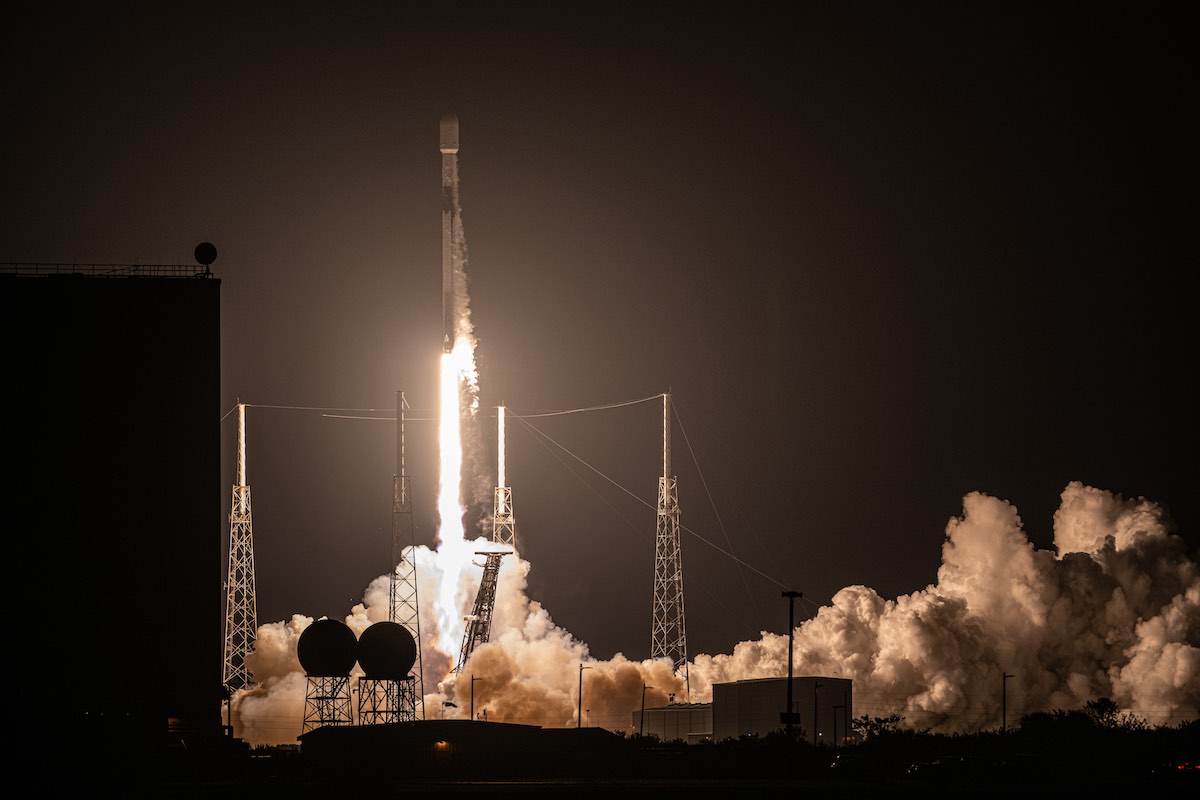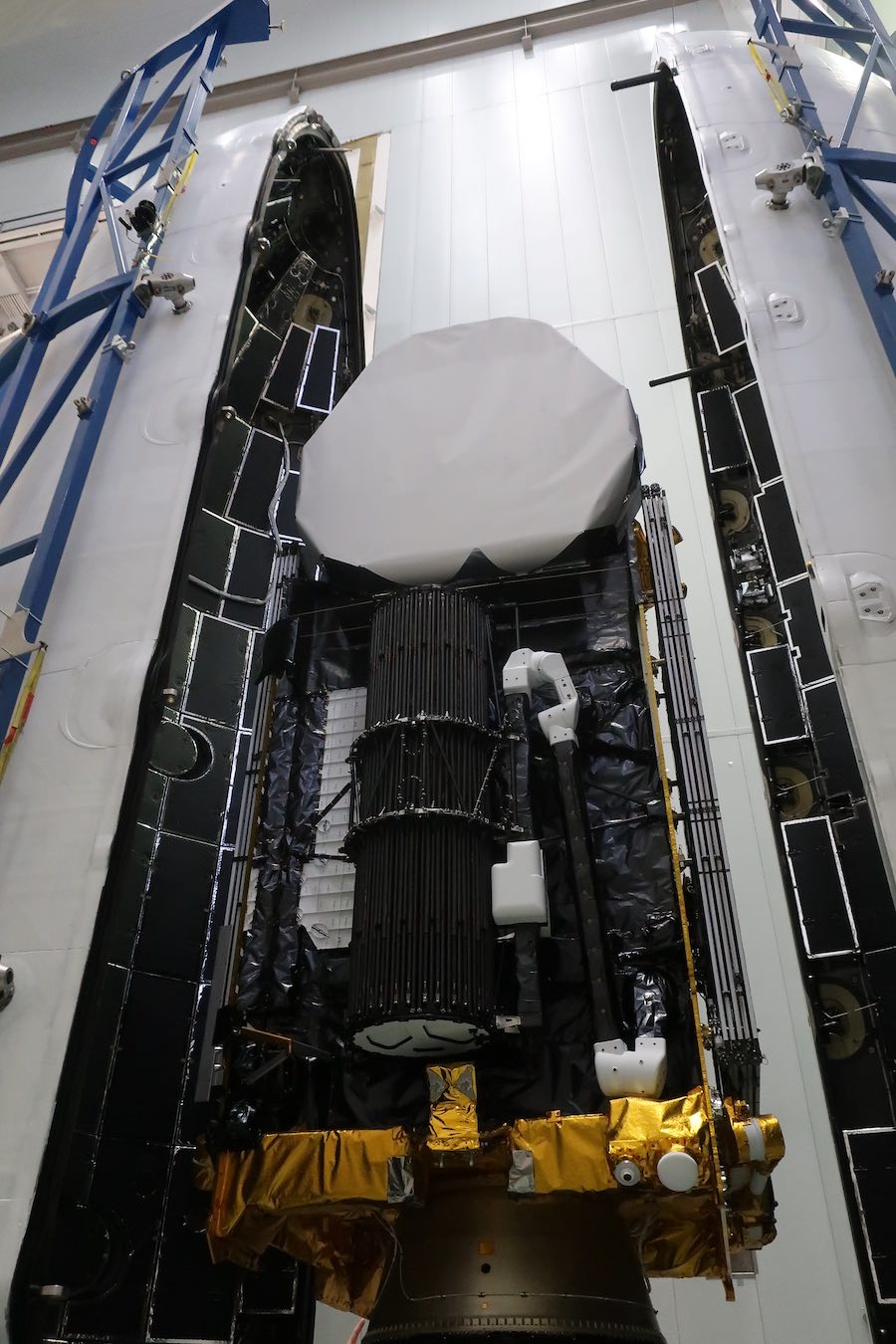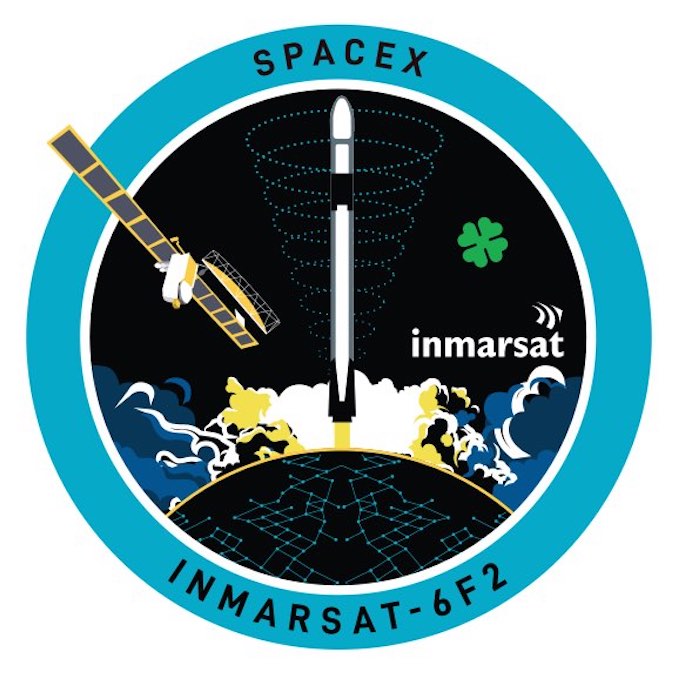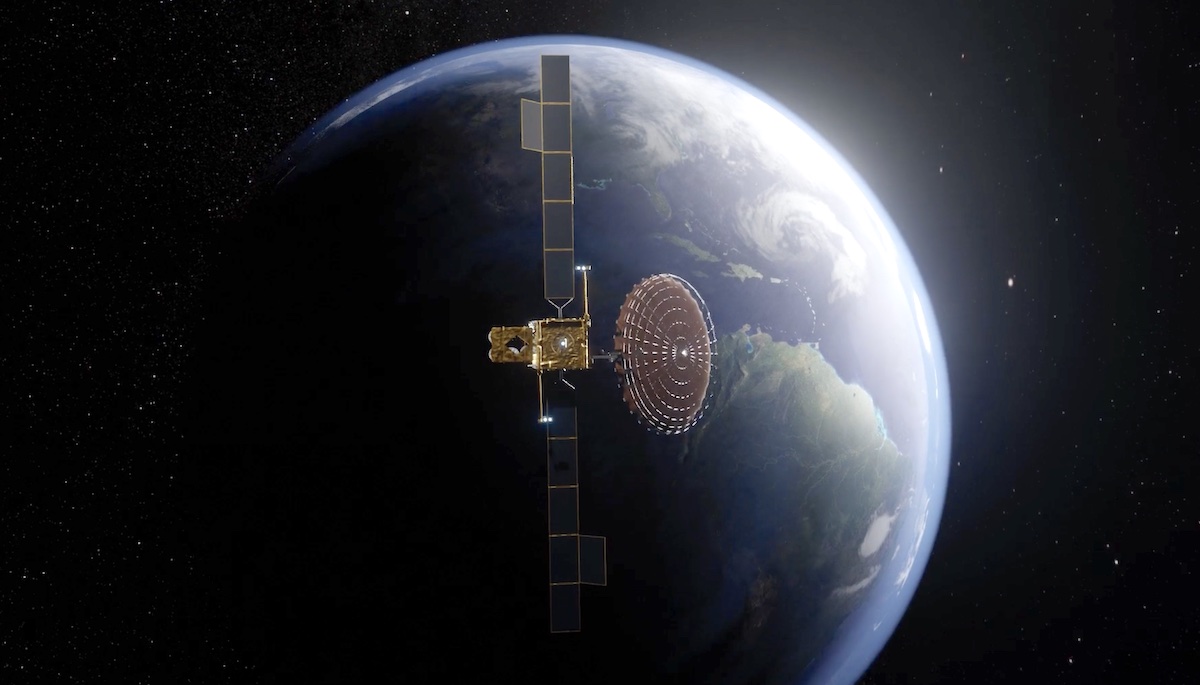Watch a replay of our live coverage of the countdown and launch of a SpaceX Falcon 9 rocket from Space Launch Complex 40 at Cape Canaveral Space Force Station, Florida. The Falcon 9 rocket launched the Inmarsat 6 F2 communications satellite. Follow us on Twitter.
SFN Live
SpaceX completed a launch doubleheader Friday night with the liftoff of a Falcon 9 rocket from Cape Canaveral carrying a dual-band, six-ton mobile communications relay station for London-based Inmarsat, hours after launching another Falcon 9 from California with a batch of Starlink internet satellites.
The Friday night launch from Cape Canaveral began at 10:59 p.m. EST (0359 GMT Saturday), less than nine hours after a Falcon 9 rocket took off from Vandenberg Space Force Base in California.
The Falcon 9’s nine Merlin engines, generating 1.7 million pounds of thrust, powered the 229-foot-tall (70-meter) launcher east from Cape Canaveral to deliver Inmarsat’s new communications satellite into an elongated geostationary transfer orbit stretching more than 20,000 miles (more than 34,000 kilometers) above Earth at its highest point, and as low as 155 miles (250 kilometers) at the point closest to Earth.
The rocket’s upper stage released the Inmarsat 6 F2 satellite into orbit about 32 minutes after liftoff, following two picture perfect engine firings with its single Merlin engine. The first stage of the Falcon 9, flying for the third time, returned to Earth for landing on a drone ship east of Cape Canaveral in the Atlantic Ocean about eight-and-a-half minutes after launch.

The Inmarsat 6 F2 spacecraft, based on Airbus’s Eurostar 3000e satellite platform, checked in with ground controllers soon after separating from the Falcon 9 rocket.
Now safely in orbit, the satellite will begin a series of health checks and a partial deployment of its power-generating solar arrays. Once the satellite’s thrusters move the perigee, or low point, of its orbit safely above the atmosphere, ground teams will send commands to a full deployment of the solar arrays and the unfurling of a large 30-foot (9-meter) umbrella-like L-band antenna reflector next week.
Then the satellite will continue reshaping its orbit using the electric propulsion system, which is lighter and more efficient than conventional liquid-fueled maneuvering rockets. The plasma thrusters are positioned on the ends of articulating robotic arms, providing precise pointing as the satellite circularizes its orbit and moves from an inclination of 27 degrees — the drop-off orbit SpaceX will reach with the Falcon 9 — to a position directly over the equator.
With a solar array wingspan as wide as a Boeing 767 jetliner and a body the size of a double-decker bus, the Inmarsat 6 F2 spacecraft will be parked in geostationary orbit more than 22,000 miles (nearly 36,000 kilometers) over the Earth, using a dual-band communications payload provide in-flight WiFi on aircraft, broadband services to ships, and connectivity for U.S. military and other government users.
Liftoff of a Falcon 9 rocket from Cape Canaveral on SpaceX’s second launch of the day, carrying an Inmarsat mobile communications satellite to geostationary transfer orbit. https://t.co/H5UemP5ayu pic.twitter.com/JSxBMBhbtC
— Spaceflight Now (@SpaceflightNow) February 18, 2023
The Inmarsat 6 F2 spacecraft weighed 12,048 pounds (5,465 kilograms) at launch, with more than a ton of that mass consisting of xenon gas to fuel the satellite’s electric propulsion system, according to a company spokesperson.
“It is one of the world’s largest spacecraft in terms of weight and power, but inside of it, I think the thing that makes it unique is all the signal processing that goes on,” said Peter Hadinger, Inmarsat’s chief technology officer.
“It’s an incredibly advanced signal processor that’s capable of forming beams on the Earth and moving them around in real-time, creating channels as we need them, moving the spacecraft’s power to where it’s required on the face of the Earth,” Hadinger told Spaceflight Now in a pre-launch interview. “And that makes it a very capable spacecraft because we can take all the spacecraft’s energy and put it where it’s needed on a moment-by-moment basis.”

Inmarsat 6 F2 is the twin of another satellite, Inmarsat 6 F1, that launched in December 2021 on a Japanese H-2A rocket. Both Inmarsat 6 satellites use electric propulsion for their in-orbit maneuvers, and host L-band and Ka-band communications payloads targeted at different segments in the mobile communications market.
The satellite has 20 steerable wideband Ka-band beams to provide broadband connectivity to airplane passengers and ships at sea, along with the L-band reflector that will open up in space. The L-band antenna and solar panels are stowed against the body of the spacecraft to fit inside the nose cone of SpaceX’s rocket.
The L-band payload is tailored for lower-bandwidth applications, such as maritime search and rescue, ship and asset tracking, and supply chain management. Inmarsat’s most recent fleet of L-band communications satellites was the Inmarsat 4 series launched between 2005 and 2013, and the two Inmarsat 6 satellites will replace them. Each Inmarsat 6 satellite provides 50% more L-band communications capacity than the entire four-spacecraft Inmarsat 4 fleet.
The Inmarsat 5 satellites, providing Ka-band connectivity through the company’s Global Xpress service, launched between 2013 and 2019.
The two Inmarsat 6 satellites will extend Inmarsat’s narrowband L-band services, used around the world in maritime operations, until around 2040. Inmarsat is planning to launch additional Ka-band satellites in the next few years, including two Ka-band instruments on satellites in a high-inclination orbit to extend broadband coverage over the Arctic. The Arctic mission is slated to launch late this year on another SpaceX rocket from California.
The I6 F2 satellite should reach its operational position in geostationary orbit in September. The electric propulsion system is lower-thrust than conventional liquid-fueled orbit-raising engines, but is also more efficient and less massive, meaning satellite manufacturers can outfit their spacecraft with more communications capacity.
That is the case with the Inmarsat 6 satellites. I6 F1 is about to enter operational service over the Indian Ocean in the next couple of months, and will provide services across a region spanning from Africa to Asia. I6 F2 should be ready for the start of commercial services by the end of this year, according to Hadinger.
“The real important thing is that it adds a tremendous amount of new capability to all those narrowband devices, whether they’re handheld phones, or emergency communication devices that couple along with our wideband services for redundancy,” Hadinger said.

The L-band payload is good for all-weather communications, which is useful in maritime safety. The L-band service can also support commercial drones for disaster response and medical delivers, asset tracking and internet of things applications, and autonomous transportation. The Ka-band payload will be capable of higher-speed connectivity, such as internet services, at speeds of tens or hundreds of megabits per second.
“This spacecraft will be over the Atlantic, and the hotspots that it fills will probably be initially along the East Coast of the United States,” Hadinger said of the I6 F2 mission.
The new Inmarsat satellites, including I6 F2, are crucial for the company’s plans to maintain its market position as constellations of low Earth orbit satellites, like SpaceX’s Starlink fleet and OneWeb’s network, begin operational service to provide broadband internet connectivity. Starlink and OneWeb’s business strategies include serving consumers on land, in the air, and at sea.
Inmarsat was established in 1979 to develop a network of satellites to provide a communications lifeline for maritime safety and distress messages. The maritime safety mission is still part of Inmarsat’s network, but the company has evolved to provide a broader menu of communications services.
“Inmarsat is focused exclusively on mobility,” Hadinger said. “We do not serve residential consumers and fixed businesses so much. Our focus is on the maritime industry, the aviation industry, and governments, with a little bit of portable land requirements thrown in.
“But the majority of things we do are on the move, and that really causes us to focus on frequency bands and satellites which allow us to communicate with small antennas because if you’re going to be on the move, you need to have an antenna that’s buried in the skin of an aircraft or which is on a ship, and these things are rolling and rocking on the way,” Hadinger said. “So all of this has to be tracked and handed off from beam to beam and from satellite to satellite as the user moves around the world.”
Inmarsat plans to launch the Arctic Satellite Broadband Mission later this year, in partnership with Norway and the U.S. Space Force. Then Inmarsat’s GX 7, GX 8, and GX 9 satellites — the next spacecraft to augment the company’s Ka-band network — will launch in late 2024 or early 2025, Hadinger said.
“The I6 spacecraft will be joined by a further five major scale satellites by 2025,” said Rajeev Suri, CEO of Inmarsat. “Each of these has the capability to deliver focused connectivity over a larger region and come with certainty — in resilience, in robustness, in service quality — that is unique to Inmarsat.”

During Friday night’s countdown, the Falcon 9 launcher was filled with a million pounds of kerosene and liquid oxygen propellants in the final 35 minutes before liftoff.
After teams verified technical and weather parameters were all “green” for launch, the nine Merlin 1D main engines on the first stage booster flashed to life with the help of an ignition fluid called triethylaluminum/triethylborane, or TEA-TEB. Once the engines ramped up to full throttle, hydraulic clamps opened to release the Falcon 9 for its climb into space.
The nine main engines produced 1.7 million pounds of thrust for more than two-and-a-half minutes, propelling the Falcon 9 and Inmarsat 6 F2 into the upper atmosphere. Then the booster stage shut down and separated from the Falcon 9’s upper stage to begin a controlled descent toward SpaceX’s drone ship “Just Read the Instructions” parked in the Atlantic Ocean about 410 miles (about 665 kilometers) east of Cape Canaveral.
The booster, designated B1077, extended titanium hypersonic grid fins and used cold gas nitrogen thrusters to control its orientation, then reignited three of its nine main engines for a 30-second braking maneuver during re-entry. A final landing burn with just the center engine slowed the rocket for touchdown on the drone ship about eight-and-a-half minutes into the mission.
A SpaceX recovery ship was also in position in the Atlantic to recover the Falcon 9 rocket’s payload fairing after the nose cone’s two clamshell halves parachuted into the sea. The payload fairing jettisoned from the rocket about three-and-a-half minutes into the flight, shortly after ignition of the Falcon 9’s upper stage engine.
Inmarsat 6 F2 separation.
Inmarsat's new Airbus-built satellite for maritime & airborne communications has separated from the Falcon 9 rocket in geostationary transfer orbit.
After orbit-raising, the satellite will enter service late this year.https://t.co/14Dhaa9mUQ pic.twitter.com/ckVWKBPBD6
— Spaceflight Now (@SpaceflightNow) February 18, 2023
The Falcon 9 rocket fired its upper stage engine two times to inject the Inmarsat 6 F2 spacecraft into an elliptical geostationary transfer orbit. Payload separation was confirmed at T+plus 32 minutes and 14 seconds, and a live camera view from the Falcon 9’s upper stage showed the satellite flying free from the rocket over Africa to begin its journey to geostationary orbit.
With Friday’s launch doubleheader complete, SpaceX’s next mission is scheduled for Feb. 23 from Cape Canaveral carrying another set of Starlink internet satellites to space.
ROCKET: Falcon 9 (B1077.3)
PAYLOAD: Inmarsat 6 F2 communications satellite
LAUNCH SITE: SLC-40, Cape Canaveral Space Force Station, Florida
LAUNCH DATE: Feb. 17, 2023
LAUNCH WINDOW: 10:59 p.m.-12:28 a.m. EST on Feb. 17/18 (0359-0528 GMT on Feb. 18)
WEATHER FORECAST: 75% probability of acceptable weather
BOOSTER RECOVERY: Drone ship “Just Read the Instructions” about 410 miles (665 kilometers) east of Cape Canaveral
LAUNCH AZIMUTH: East
TARGET ORBIT: Geostationary transfer orbit — 155 miles by 21,561 miles (250 by 34,700 kilometers); Inclination of 27 degrees
LAUNCH TIMELINE:
- T+00:00: Liftoff
- T+01:12: Maximum aerodynamic pressure (Max-Q)
- T+02:31: First stage main engine cutoff (MECO)
- T+02:35: Stage separation
- T+02:36: Second stage engine ignition
- T+03:23: Fairing jettison
- T+06:20: First stage entry burn ignition (three engines)
- T+06:49: First stage entry burn cutoff
- T+08:09: Second stage engine cutoff (SECO 1)
- T+08:12: First stage landing burn ignition (one engine)
- T+08:42: First stage landing
- T+26:10: Second stage engine restart
- T+27:13: Second stage engine cutoff (SECO 2)
- T+32:14: Inmarsat 6 F2 separation
MISSION STATS:
- 205th launch of a Falcon 9 rocket since 2010
- 215th launch of Falcon rocket family since 2006
- 3rd launch of Falcon 9 booster B1077
- 175th Falcon 9 launch from Florida’s Space Coast
- 114th Falcon 9 launch from pad 40
- 169th launch overall from pad 40
- 145th flight of a reused Falcon 9 booster
- 2nd SpaceX launch for Inmarsat
- 11th Airbus-built satellite launched by SpaceX
- 11th Falcon 9 launch of 2023
- 12th launch by SpaceX in 2023
- 9th orbital launch attempt based out of Cape Canaveral in 2023
Email the author.
Follow Stephen Clark on Twitter: @StephenClark1.
